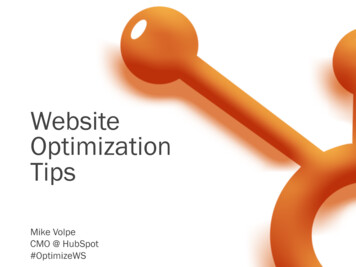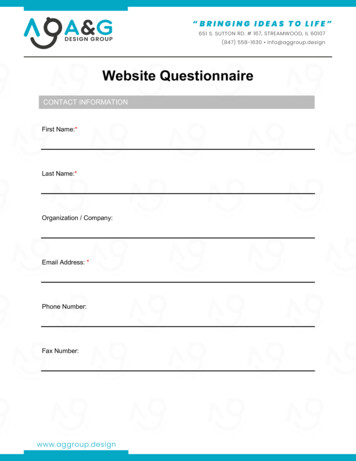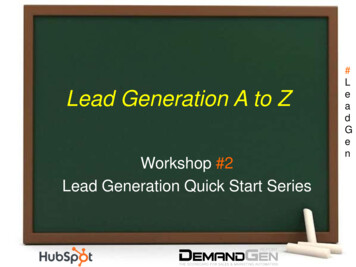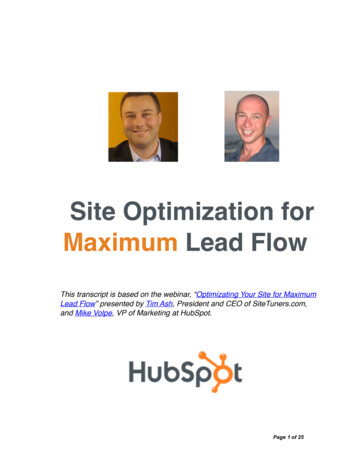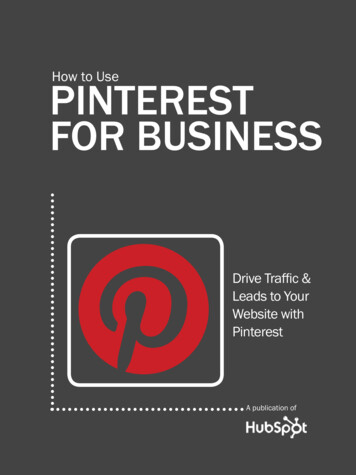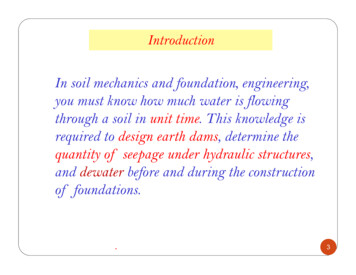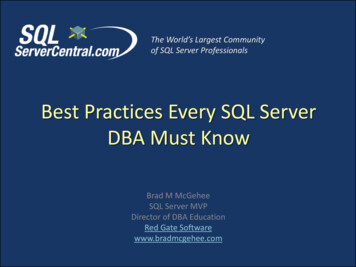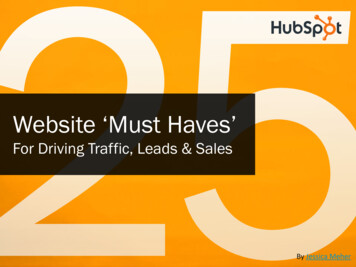
Transcription
Website ‘Must Haves’For Driving Traffic, Leads & SalesBy Jessica Meher
TABLE OF CONTENTSIntroduction .3Part 1: Get Found Online 4Building Inbound Links 7On-page SEO 9Title Tag & Meta Tags 11XML Sitemaps 13301 Redirects 14Part 2: Design & Usability 15The First Impression .16Maintain Consistency .19Using the Right Images .20Navigation 21Flash and Animation,,,,, 23Accessibility .24Part 3: Content . 25Messaging .26Educate and Offer Value 28Importance of Quality .29Avoid Corporate Gobbledygook .31Be Clear Not Clever .32Blogging .33Making Content Social and Shareable 35Other Forms of Content 36Customer Proof .37Part 4: Conversion .39Effective Call-to-Actions 40CTA Positioning .43Landing Pages 45Forms 49Newsletters .51Conclusion . 52
IntroductionWe all know how important a website is to a business's online strategy. Almost every business,whether B2B, B2C, non-profit, local or global needs an online presence to reach buyers in theinternet age. A company’s website is its virtual storefront.Shockingly, a recent survey by 1&1 Internet reported thatup to 40% of small-to-medium sized businesses still don’thave a website. Even if you’re on social media, operatingwithout a website is just silly. A website is an essentialpiece of your online marketing strategy.Whether you're looking to build your first website, or if yourexisting site just isn't getting the traffic or leads you werehoping for, you may wonder what it really takes to have agreat website.A recent survey by1&1 Internet reportedthat up to 40% ofsmall-to-medium sizedbusinesses still don’thave a website.Having a website alone isn’t the key to great results. Instead, it’s the ability turn your website intoan inbound marketing machine. Your website has a hefty goal and it needs to wear many hats. Awebsite needs to not just exist, it needs to perform. It needs to attract visitors, educate them andconvince them to buy. But I know what you’re thinking - easier said than done.Tweet this Webinar Share on Facebook Share on LinkedIn3
Today, the web is social and interactive. It’s not static like most websites tend to be. As such, awebsite can no longer sustain as its own island. We now need to consider integrating search, socialmedia, content, blogging, and more with our websites. Gone are the days where all it took was aURL, fancy Flash graphics, and an expensive advertising campaign to temporarily boost traffic.The reason for this shift is largely due to changing buyer behavior. Today’s buyer wishes toconsume information when they want and how they want and often-times without the involvementof a sales person. And more importantly, they want to be educated and not sold to. As you can seefrom the following chart, websites and new forms of inbound marketing content (such as podcasts,blogging and social media) have become a considerable factor in the buying cycle.Image credit: Technoligence, LLC.Tweet this Webinar Share on Facebook Share on LinkedIn4
You’ll also find in HubSpot’s 2011 State of Inbound Marketing Report that inbound marketing ismore effective in reaching today’s buyer. Results show that inbound marketing has a 62% lesscost per lead compared to outbound, or traditional, marketing.What might not be apparently visiblehere is the role your website plays. It’sactually a big one. In most cases, trafficfrom blogs, social media, organic andpaid search end up converting intoleads or sales on your main website.Without a website acting as an onlinebasecamp, it would be difficult to attractnew business to one source.This is why having an effective website is so crucial and that it contains key elements to drivingmore traffic, leads, and sales.So without further ado, I present to you 25 Website ‘Must Haves’ for Driving Traffic, Leads andSales. To learn more about a particular must-have, you’ll find additional resources at the bottomof each topic. Definitely take advantage of these if you’re looking to master inbound marketing.Tweet this Webinar Share on Facebook Share on LinkedIn5
Part 1: Get Found OnlineA great website isn’t so great if no one visits it. This is why the first chapter isdedicated to getting found online, which covers the very top of the funnel ofyour inbound marketing strategy. Search Engine Optimization (SEO) is anabsolute must-have to any website strategy, but it takes hard work andconsistency when aiming for the top spot. These tips will help get you on yourway to increasing your organic (non-paid) search engine rankings.Tweet this Webinar Share on Facebook Share on LinkedIn6
Get Found Online:Building Inbound LinksBuilding Inbound LinksEvery website on the internet has the goal of reaching the #1position in search engines but because there is only one topspot per keyword phrase, not everyone can make it. So whatgets a first place ranking? Off-page search engineoptimization (SEO) is the most important factor to increasingyour ranking results.Off-Page SEO is about building inbound links, essentiallygetting other quality websites to link back to you. Searchengines call this authority or “link juice.” The more inboundlinks you have, the more important your site must be, thus thehigher you’ll rank.Link building, when done right, isn’t easy since adding links to other websites is sometimes out of yourcontrol. Here are some tips to building inbound links:Tweet this Webinar Share on Facebook Share on LinkedIn7
Get Found Online:Building Inbound Links Create high-quality, educational or entertaining content. If people like your content, theywill naturally want to link to it. Submit your website to online directories (check out this list here). This is an easy way tostart. Write guest posts for other blogs. This is a win-win for both parties. People will want extra(quality) content from others and in exchange, it’s a great way to build inbound links. Researching link building opportunities with other websites, but always check theauthority of the websites that you are trying to get links from. There are many tools online thatallow you to check domain or page authority, including HubSpot's link grader tool. And don’t borrow, beg, barter, bribe or buy links.To learn more, see:An Introduction to Link Building:Understanding the Anatomy of a LinkTweet this Webinar Share on Facebook Share on LinkedIn8
Get Found Online:On-page SEOOn-page Search EngineOptimization (SEO)While off-page SEO is hugely important, we can’t forget about onpage SEO. This consists of placing your most important keywordswithin the content elements of your actual pages. These on-pageelements include Headlines, Sub-headlines, Body Content, ImageTags, and Links. Often times on-page SEO is referred to as“keyword density.”It’s very common that businesses will do too little on-page optimization or too much (keywordstuffing). While it’s important to include your keyword as many times as necessary within a page,you don't want to go overboard with it either. For on-page SEO done right: Pick a primary keyword for each page and focus on optimizing that page for that word. If youoversaturate a page with too many keywords on one page, the page will lose its importance andauthority because search engines won’t have a clear idea of what the page is about. This is verycommon on homepages in particular, where too many keywords are used.Tweet this Webinar Share on Facebook Share on LinkedIn9
Get Found Online:On-page SEOExample of a clean URL containing primary keywords: Place your primary keywords in yourheadline and sub-headline. These areas ofcontent have greater weight to searchengines. Include the keywords in the body contentbut don't use them out of context. Make surethey are relevant with the rest of your content. Include keywords in the file name ofimages (e.g. mykeyword.jpg) or use them inthe ALT tag. Include the keywords in the page URL andkeep the URL clean. And lastly, write for humans first, searchengines second. Always prepare yourcontent for your audience and then look tooptimize it for search. Content written in theother order won’t read naturally and yourvisitors will recognize it.More Resources6 Ways to Immediately Amplify YourOn-Page SEOTweet this Webinar Share on Facebook Share on LinkedIn10
Get Found Online:Title Tag & Meta TagsTitle Tag & Meta TagsWhile this may be the least sexiest component of SEO, it is adefinite must-have. A Meta Tag is a line of code that is containedin the background of a web page. Search engines look at metatags to learn more about what the page is about.Meta tags don’t quite have the level of SEO importance as theyused to but are still very important. Back in the day, websitesabused meta tags to increase their rankings by including far toomany keywords. Now search engines are smarter and give moreweight to inbound links and page content for ranking instead.However, they still play an important role to an SEO strategy.Make sure to use these on all of your pages.If you’re not a web guru, most website editors and content management systems enable you toeasily edit meta tags without coding knowledge. If you don’t have an editor, you can simply open aweb page file (ending in .htm, .html, .asp or .php) in Notepad or a plain text editor and the meta tagswill be found near the top of the document.Tweet this Webinar Share on Facebook Share on LinkedIn11
Get Found Online:Title Tag & Meta TagsHere is example of what meta tags look like in an HTML document: Title: The title of the page seen at the top of a web browser, also the main headline displayed insearch engine results. title HubSpot Inbound Marketing Software /title Description: A concise description of the page. meta name "Description" content "Stop pushing. Start attracting. Stopinterrupting. Start engaging. HubSpot's Inbound Marketing Software." How the Title andDescription tags aredisplayed in searchengine results Keywords: Words that identify what the page is about. Keep to less than 7 keywords per page.Keywords in meta tags are not visible in the search engine results like Title and Description. meta name "keywords" content "inbound marketing, marketing software" More Resources3 Meta Description Mistakes You Might Be MakingTweet this Webinar Share on Facebook Share on LinkedIn12
Get Found Online:XML SitemapsXML SitemapsThe general incentive behind an XML sitemap is to help search enginecrawlers (or “spiders”) sift through your pages more efficiently. An XMLsitemap is simply an .xml file containing a listing of all your pages andwhen they were updated. It’s a lot like a subway map. It shows thestructure of your website and where are your pages reside.Creating a sitemap is easy. You can find sitemap generators online thatwill create the .xml file for you. Once you get the .xml file, simply upload itto the root directory of your website (e.g. www. website.com/sitemap.xml).If your website is updated regularly, make it a good practice to update your xml file at least once amonth so search engines have the freshest data.Adding an XML sitemap is a component that is commonly overlooked, while it may not be thedeciding factor in improving your Search EngineOptimization, it will certainly help.More Resources3 Ways to Use Google WebmasterTools to Increase Search Engine TrafficTweet this Webinar Share on Facebook Share on LinkedIn13
Get Found Online:301 Redirects301 RedirectsTraffic and LinksWe’ve all experienced a time when we clicked on a website link thatended up being broken. Typically you’ll see a “404 message” or“Page Not Found.” A lot of times this is caused whena page is moved to a new URL and the old linkhasn’t been directed to the new page. Thinkabout the lost opportunity when your customersor potential buyers want information that they can’tlocate. If you choose to move a page on your website, make certainthat you use a permanent 301 Redirect, a method used to change an old URL to a new one.In addition to keeping visitors happy when navigating your website, permanent 301 redirects arealso important for SEO. When a user can’t find a new page, nor can a search engine, and you’lllose any SEO status the old page once had. To keep the SEO juice following to new pages, set upa 301 redirect for pages that have been moved sosearch engines know where to find it.More ResourcesThe 301 Redirect: How To Change Your WebsiteAddress Without Losing Search RankingsTweet this Webinar Share on Facebook Share on LinkedIn14
Part 2: Design & UsabilityNow that you’re generating some good traffic by getting found online, your nextfocus is getting that traffic to stay on your website. It depends on the industry, butmost websites have a 30-60% bounce rate on average. This means a large majorityof web traffic entering your website leaves without navigating to any other pages.And many times they may never come back. Yikes! Here are some tips you need toconsider to improve user experience and decrease your bounce rate.Tweet this Webinar Share on Facebook Share on LinkedIn15
Design & UsabilityThe First ImpressionThe First ImpressionYour website represents who you are and what you offer. When peoplesee it for the first time they’re thinking: Is this site credible?Is it trustworthy?Is this a professional company?Is this company stable?Does this site make me feel welcome?Am I in the right place?You need to ask yourself all of these questions when designing your website. Now, design may not bethe most important factor in a website overall and often-times folks put too much emphasis on how asite looks instead of it works, but it does play an important role in making a good first impression.For example, an in-depth study from the Stanford University and Consumer Web Watch, "How DoPeople Evaluate A Website's Credibility? Results from a Large Study," found that a website's designwas more important than credibility indicators such having a privacy policy, awards or certifications.P-44 Technologies does a great job at summarizing this study (continue to next page ).Tweet this Webinar Share on Facebook Share on LinkedIn16
Design & UsabilityThe First Impression“Visitors first evaluate a site's overall design, including its use of multimedia. Beau Brendler,director of Consumer Web Watch noted: "While consumers say they judge on substance,these studies demonstrate that consumers judge on aesthetics, and get distracted by bellsand whistles." So, after spending all this time developing great, valuable content that visitorscan't find anywhere else on the Web, does this mean nothing matters but a cool colorscheme and fancy flash animation? Fortunately, it doesn't. The Stanford study notedspecifically that while a site's design is the first indicator of quality, it isn't the only one: " thevisual design may be the first test of a site's credibility. If it fails on this criterion, Web usersare likely to abandon the site and seek other sources of information and services.”Tips for a great website design: Proper use of colors: Use the right colors for your audience and to draw attention to selectelements. Don’t try to make everything jump out. The result will be just the opposite – nothingwill stand out. Avoid a chaotic mix of colors on your website and instead pick two to four colorsfor your template and marketing materials. Animations, gadgets and media: Avoid anything unnecessary. Using Flash animationsbecause they look cool is the wrong strategy. In most cases it’s best not to use animatedbackground or background music. Only use media and animations to help support contentand information.Tweet this Webinar Share on Facebook Share on LinkedIn17
Design & UsabilityThe First Impression Layout: Create a clear navigation structure (refer to Navigation on page 21) and organizepage elements in a grid fashion (as opposed to randomly scattered). Also, don’t be afraid ofwhite space and avoid clutter! Typography: Make sure your website is legible. Use fonts, font sizes and font colors that areeasy to read. For easier page scanning, use bullet lists, section headers, and shortparagraphs. If your site is English language-based, make sure information flows from left toright and top to bottom.While design is important, don’t forget that offering great content is what your visitors areultimately after. A well-designed website might convince visitors to take a closer look but they won'tlook twice if the content isn't useful and well organized. After all, you never get a second chanceto make a first impression.More ResourcesLearn how to edit your own website, no coding skillsrequired, with HubSpot’s Content Management SystemTweet this Webinar Share on Facebook Share on LinkedIn18
Design & UsabilityConsistencyMaintain ConsistencyIt’s best to keep elements on your site fairly consistent from page-to-page. Elements includecolors, sizes, layout and placement of those elements. Your site needs to have a good flow frompage to page. This means colors are primarily the same as well as fonts and layout structure.Navigation should remain in the same location of your layout throughout your website.Consistentdesignelementssuch asLogo,Navigation,Links &ColorsHOMEPAGESUB-PAGEFor layout structure, typically three page layouts exist for most websites: one for the homepage,one for content pages and one for form pages. For example, your homepage will have a differentlayout than a landing page for a PPC campaign. Keepthe elements in these layouts constant. This will helpMore Resourceskeep your visitors from feeling lost.What REALLY Matters in a Website Redesign.Tweet this Webinar Share on Facebook Share on LinkedIn19
Design & UsabilityImagesUsing the Right ImagesImages can be a powerful element to any website but you need to usethem wisely. For example, consider stock photography. Stock imagesare seen everywhere because they are easily accessible andinexpensive. But are they good to use?I am a happycustomer!!NOT!Marketing Experiments performed a test comparing the use of stockphotography verses real imagery on a website and each of their effectson lead generation. What they found was that photos of real people outperformed the stock photos by 95%. Why? Because stock images tendto be irrelevant. Resist the temptation to use photos of fake smilingbusiness people!As a result, take care to place meaningful images on your site. Every image is transmitting asubconscious message to your audience and sometimes the result is different from what mightexpect. I’d recommend looking into another study by MarketingExperiments “Images vs. Copy: How getting the right balanceincreased conversion by 29%.”More ResourcesExpert Advice: Creating DivineWebsite RedesignsTweet this Webinar Share on Facebook Share on LinkedIn20
Design & UsabilityNavigationNavigationPerhaps one of the biggest factors to keep visitors on your website is having a good, solidnavigation system that supports all search preferences. In fact, more than three-quarters ofsurvey respondents from a recent HubSpot study say that the most important element in websitedesign is ease in finding information.Source: Science of Website RedesignTweet this Webinar Share on Facebook Share on LinkedIn21
Design & UsabilityNavigationIf people can’t find what they are looking for, they will give up and leave. Important factors in asite’s navigation include: Keep the structure of your primary navigation simple (and near the top of your page). Include navigation in the footer of your site. Use breadcrumbs on every page (except for the homepage) so people are aware of theirnavigation trail. Include a Search box near the top of your site so visitors can search by keywords. Don’t offer too many navigation options on a page. Don’t dig too deep – in most cases it’s best to keep your
website needs to not just exist, it needs to perform. It needs to attract visitors, educate them and convince them to buy. But I know what you’re thinking - easier said than done. 3 . allow you to check domain or page authority, including


